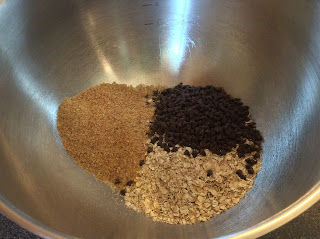This is one of my favorite recipes to have as a snack. They are full of fiber, and depending what kind of butter you use, can be full of protein too. I don't know the exact calorie count, but I have to guess it is between 50 and 75 calories per 1 inch energy ball.
1. Gather your ingredients and a large mixing bowl.
-1 cup dry oatmeal
-1/2 cup chocolate chips
-1/2 cup peanut butter
-1/2 cup ground flaxseed
-1/3 cup honey
-1 tsp. vanilla
Simple and Easy! You might have noticed from the picture that there is not peanut butter there, but something different. I am allergic to peanuts, so I cannot put the peanut butter in it, so we had to find some alternatives. What is in the picture is sunbutter, which is made from sunflower seeds. People have told me that it tastes better than peanut butter and it is a lot healthier for you too! It has more vitamins, potassium, and a lot less sugar than your usual Jif or Skippy. Sunbutter is a great alternative for people who are allergic to peanuts, and they make sure that it is made in a completely peanut-free facility. It is also great if you want to try something different!
Anyways, back to the recipe
2. Put all your dry ingredients(oatmeal, flax seed, chocolate chips) in a bowl.
3. Add your wet ingredients (honey, vanilla, peanut butter)
4. Mix it thoroughly, making sure that there are no big clumps of any one ingredient.
5. Form into about 1 inch balls. Yield: about 10-20, depending on how big you want them to be.
Thanks for reading this! Please try this recipe if you are a chocolate lover, but also want to get in some good fiber and protein. For more chocolaty balls, add more chocolate instead of honey. Please complete the poll! Make sure you check out all the fact files! We have a lot of more healthiness coming!
For the full recipe, go to:




